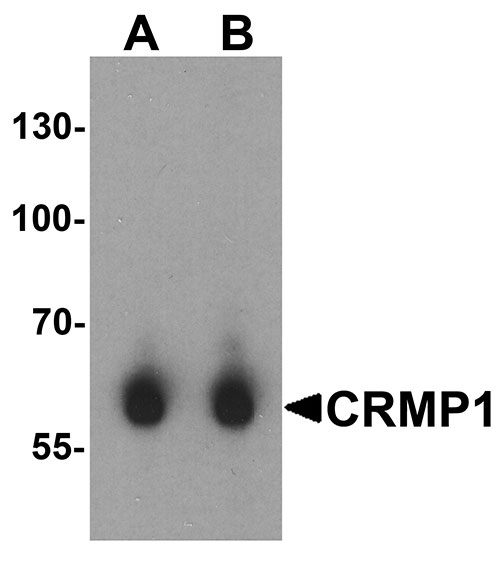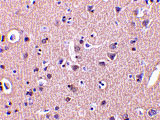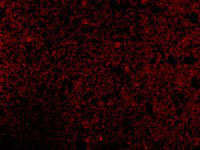CRMP1 Antibody
- 产品详情
- 实验流程
- 背景知识
Application
| WB, IF, E, IHC-P |
|---|---|
| Primary Accession | Q14194 |
| Other Accession | AAH07613, 14043246 |
| Reactivity | Human, Mouse, Rat |
| Host | Rabbit |
| Clonality | Polyclonal |
| Isotype | IgG |
| Calculated MW | 62184 Da |
| Concentration (mg/ml) | 1 mg/mL |
| Conjugate | Unconjugated |
| Application Notes | CRMP1 antibody can be used for the detection of CRMP1 by Western blot at 0.5 - 2 µg/mL. Antibody can also be used for immunohistochemistry starting at 2 µg/mL. For immunofluorescence start at 10 µg/mL. |
| Gene ID | 1400 |
|---|---|
| Other Names | CRMP1 Antibody: DRP1, DRP-1, CRMP-1, DPYSL1, ULIP-3, ULIP3, Dihydropyrimidinase-related protein 1, Collapsin response mediator protein 1, collapsin response mediator protein 1 |
| Target/Specificity | CRMP1; |
| Reconstitution & Storage | CRMP1 antibody can be stored at 4℃ for three months and -20℃, stable for up to one year. As with all antibodies care should be taken to avoid repeated freeze thaw cycles. Antibodies should not be exposed to prolonged high temperatures. |
| Precautions | CRMP1 Antibody is for research use only and not for use in diagnostic or therapeutic procedures. |
| Name | CRMP1 |
|---|---|
| Synonyms | DPYSL1, ULIP3 |
| Function | Necessary for signaling by class 3 semaphorins and subsequent remodeling of the cytoskeleton (PubMed:25358863). Plays a role in axon guidance (PubMed:25358863). During the axon guidance process, acts downstream of SEMA3A to promote FLNA dissociation from F-actin which results in the rearrangement of the actin cytoskeleton and the collapse of the growth cone (PubMed:25358863). Involved in invasive growth and cell migration (PubMed:11562390). May participate in cytokinesis (PubMed:19799413). |
| Cellular Location | Cytoplasm. Cytoplasm, cytoskeleton, microtubule organizing center, centrosome. Cytoplasm, cytoskeleton, spindle. Cell projection, growth cone {ECO:0000250|UniProtKB:P97427}. Cytoplasm, cytoskeleton {ECO:0000250|UniProtKB:P97427}. Perikaryon {ECO:0000250|UniProtKB:P97427}. Note=Associated with centrosomes and the mitotic spindle during metaphase (PubMed:11562390). Colocalizes with FLNA and tubulin in the central region of DRG neuron growth cone (By similarity). Following SEMA3A stimulation of DRG neurons, colocalizes with F-actin (By similarity) {ECO:0000250|UniProtKB:P97427, ECO:0000269|PubMed:11562390} |
| Tissue Location | Brain. |
For Research Use Only. Not For Use In Diagnostic Procedures.
Provided below are standard protocols that you may find useful for product applications.
BACKGROUND
CRMP1 Antibody: Collapsin-response mediator proteins (CRMPs) are highly expressed in the developing brain where they play major roles in axonal outgrowth, neurite differentiation, and apoptosis. Their continued expression in areas of high synaptic remodeling such as the cerebellum, hippocampus, and the olfactory system suggests that these proteins may also be involved in adult brain plasticity. CRMP-1 was initially identified as a dihydro-pyrimidinase expressed exclusively in brain; later studies have shown that it is involved with neurotrophin (NT) 3-induced neurite formation and outgrowth. CRMP-1 localization switches from axonal to somatodendritic when neurons reach functional maturity, suggesting that it is involved in early neuronal differentiation as well as in later processes related to the survival or death of the newly generated neurons.
REFERENCES
Charrier E, Reibel S, Rogemond V, et al. Collapsin response mediator proteins (CRMPs): involvement in nervous system development and adult neurodegenerative disorders. Mol. Neurobiol. 2003; 28:51-64.
Cameron HA and McKay RD. Adult neurogenesis produces a large pool of new granule cells in the dentate gyrus. J. Comp. Neurol. 2001; 435:406-417.
Hamajima N, Matsuda K, Sakata S, et al. A novel gene family defined by human dihydropyrimidinase and three related proteins with differential tissue distribution. Gene. 1996; 180:157-63.
Quach TT, Duchemin A-M, Rogemond V, et al. Involvement of collapsin response mediator proteins in the neurite extension induced by neurotrophins in dorsal root ganglion neurons. Mol. Cell. Neurosci. 2004; 25:433-43.
终于等到您。ABCEPTA(百远生物)抗体产品。
点击下方“我要评价 ”按钮提交您的反馈信息,您的反馈和评价是我们最宝贵的财富之一,
我们将在1-3个工作日内处理您的反馈信息。
如有疑问,联系:0512-88856768 tech-china@abcepta.com.























 癌症的基本特征包括细胞增殖、血管生成、迁移、凋亡逃避机制和细胞永生等。找到癌症发生过程中这些通路的关键标记物和对应的抗体用于检测至关重要。
癌症的基本特征包括细胞增殖、血管生成、迁移、凋亡逃避机制和细胞永生等。找到癌症发生过程中这些通路的关键标记物和对应的抗体用于检测至关重要。 为您推荐一个泛素化位点预测神器——泛素化分析工具,可以为您的蛋白的泛素化位点作出预测和评分。
为您推荐一个泛素化位点预测神器——泛素化分析工具,可以为您的蛋白的泛素化位点作出预测和评分。 细胞自噬受体图形绘图工具为你的蛋白的细胞受体结合位点作出预测和评分,识别结合到自噬通路中的蛋白是非常重要的,便于让我们理解自噬在正常生理、病理过程中的作用,如发育、细胞分化、神经退化性疾病、压力条件下、感染和癌症。
细胞自噬受体图形绘图工具为你的蛋白的细胞受体结合位点作出预测和评分,识别结合到自噬通路中的蛋白是非常重要的,便于让我们理解自噬在正常生理、病理过程中的作用,如发育、细胞分化、神经退化性疾病、压力条件下、感染和癌症。








